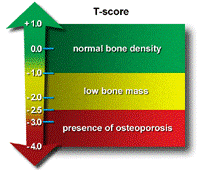What is Bone Densitometry?
A bone densitometry test is used to measure the level of mineral salts and their density in the bone. This test may be done with X-rays, dual-energy X-ray absorptiometry (DEXA), or a special CT scan that uses computer software to determine the density of spine and hip bones. For several reasons, Dexa imaging is recognized as the gold standard for accurate tests.
Bone density test results
A bone mineral density test measures your bone mineral density (BMD). Compare your BMD with two benchmark groups
, healthy young adults (your T-score) and healthy adults (your Z-score).
First, your BMD is compared with the BMD of healthy people of the same sex with the age of 25-30 years. The allowable difference or SD is the difference between your BMD and the group used for comparison. The result of this comparison is your T score. A positive T-score indicates that your bones are more hydrated than average, while a negative T-score indicates below-average bone density.

- A T score with a difference of 1SD (positive or negative) indicates normal bone mineral density
- A negative T score of 1Sd to 2.5SD indicates low bone density.
- A T score more than 2.5SD lower than the comparison group confirms the presence of osteoporosis.
Generally, the risk of bone fracture or fracture doubles for each SD decrease, so a person with a BMD one SD lower than the mean has twice the risk of fracture or osteoporosis compared to a normal person.
If this information is known, at-risk individuals can be treated to prevent future injuries. Severe osteoporosis is defined as a bone density 2.5 SD lower than Javad individuals with a history of one or more osteoporosis-related bone fractures or fractures.
Second, your BMD will be compared to people your age. The result of this comparison is called the Z score. The Z score is similar to the T score, but it is calculated by comparing with people in your age group, gender, height and weight.
In addition to measuring bone density, your doctor may prescribe other tests. Such as blood tests used to diagnose liver problems, evaluate the parathyroid gland, evaluate the effectiveness of cortisone therapy, or evaluate minerals related to bone strength, for example calcium.
?Why might I need a bone density test
Bone density measurement is often done to diagnose Osteoporosis (thin and thin bones) and Osteopenia (low bone density) so that these problems are identified as soon as possible. Early treatment helps to prevent bone cracking and fracture. Because if a bone breaks due to osteoporosis, its complications are very serious, especially in the elderly. The sooner osteoporosis is detected, the earlier the treatment process starts and the more successful it is in preventing the exacerbation of this complication.
Bone densitometry may be prescribed for the following reasons:
- Confirming the presence of osteoporosis in case of abnormal cracking or fracture
- Predicting the possibility of bone cracking or fracture in the future
- Determining the rate of loss of body bone density
- Evaluation of treatment process
There are various factors that increase the risk of osteoporosis and therefore the need to measure bone density, some of which are:
- Postmenopausal women who do not take estrogen
- Increasing age, women over 65 and men over 70
- Smoking
- Family history of hip fracture
- Long-term use of steroids or other drugs
- Some diseases, including rheumatoid arthritis, type 1 diabetes, liver failure, and hyperthyroidism.
- Excessive use of alcoholic beverages
- Low body mass index (BMI)

E. Hooshmand

E. Zarei

A. Naderimanesh


